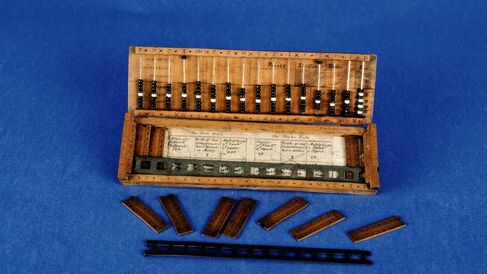John Napier's Calculating Tools

Undoubtedly one of the most influential mathematicians ever, John Napier's (1550-1617) contributions to the field were both theoretical and practical. Along with his discovery of the method of logarithms, he left his mark by devising ways to ease the labour of calculation.
Antoni van Leeuwenhoek was a Dutch cloth merchant by trade, and one of the first microscopists. He examined a wide variety of objects with his microscope - from bees to exploding gunpowder. He was probably the first person to observe and describe bacteria.
Antoni van Leeuwenhoek made a vast number of microscopes during his lifetime; 248 were sold at auction in 1747, but only 10 are thought to have survived. The microscopes themselves have a single lens and are very difficult to use, as was noted during Leeuwenhoek's lifetime. The Whipple Museum has two 19th-century reproductions by John Mayall.
In the 19th century John Mayall made copies of many early microscopes, showing both a good understanding of the instruments, and a high level of craftsmanship himself. Among the small collection of these reproductions in the collections of the Whipple Museum there are two made after the design of Antoni van Leeuwenhoek.
Life and work
Born into a family of wealthy landowners in Scotland, Napier enrolled at the University of St. Andrews, where he cultivated an interest in theology. Study in Europe gave the young Napier a taste of mathematics, which occupied his attention when not engaging in Scottish politics or tending to his estate as Baron of Murchiston.
After years of experimenting with calculation, he was able to determine a general formula for the number of times a 'base' had to be multiplied by itself to reach another value. While this notion of a logarithm appears simple now, his use of complex proportions rather than integers (hence the word 'logarithm', which roughly means 'ratio number') led him to a way of using addition and subtraction as substitutes for multiplication and division. Napier published this work in 1614 as a Description of the Wonderful Rule of Logarithms.
Napier's bones
Napier spent much of his time inventing practical ways to simplify large arithmetic problems. Three of these methods were published after his death in 1617 as a treatise, Rabdology(Image 1), a word which was a portmanteau of the Greek words for 'rod' and 'calculation'.
The most popular of these methods involved a series of numbered columns that could be laid side by side to simplify large multiplications. This was adapted from an ancient Indian method known as gelosia, so called in Renaissance Italy due to its resemblance to a kind of window design of the same name.
A tool for teaching
Because Napier's bones, also called 'speaking rods', largely eliminated the mental arithmetic required by large calculations, they became a popular tool in a society where few were educated enough to perform complex arithmetic.
The linguist and royal Master of the Ceremonies to Charles I and II, Sir Charles Cotterell (1612?-1702) designed a device combining Napier's bones with a simple abacus arranged as a portable compendium (Image 3, above). It came along with a text which advertised itself as
"[s]o easy a way, to learn and use that Art,/That even those who can neither write nor/Read, have been thereby taught all the general/Parts of it."(1)
Meant as a didactic tool, the book also catered to "skilful Artists" who wished to use the very same rods to calculate square and cube roots. Even into the 20th century, Napier's bones were an educational resource shown to students to help them think about breaking big calculations into smaller parts.
The first adding machine?
A popular way of arranging Napier's bones as rolling rods may have inspired the very first calculating machine. In 1617, the astronomer Johannes Kepler (1571-1630) discussed Napier's discoveries with his Tübingen colleague Wilhelm Schickard (1592-1635). A few years later, in 1623, Schickard wrote to Kepler describing a machine he had devised using rods and a set of gears that could mechanically carry or borrow numbers during addition and subtraction.
Unfortunately, the machine Schickard commissioned to be built for Kepler was destroyed in a fire, and Schickard's own has never been found, so only drawings and descriptions can tell us about this device. Whether Schickard deserves credit as the inventor of the first mechanical calculator, or whether that credit should go to Blaise Pascal, who invented a working machine in 1642, is a debate that still continues.
References
- Quoted in: D. Bryden, 'A Didactic Introduction to Arithmetic, Sir Charles Cotterell's 'Instrument for Arithmeticke' of 1667 (1973), History of Education 2, 1 (1973) pp. 5-18, p. 5.
Mikey McGovern
Mikey McGovern, 'John Napier's calculating tools', Explore Whipple Collections, Whipple Museum of the History of Science, University of Cambridge
